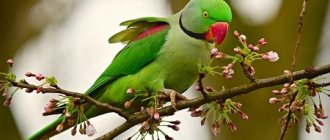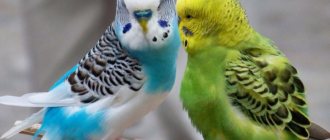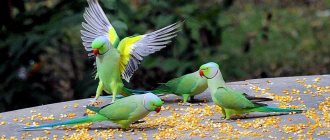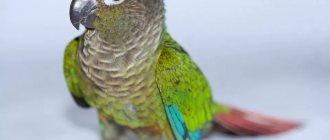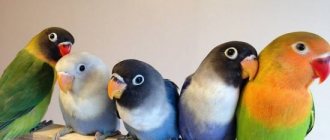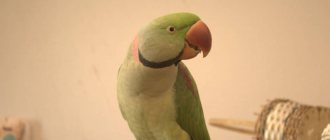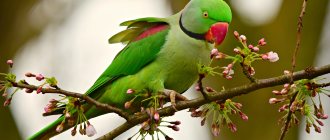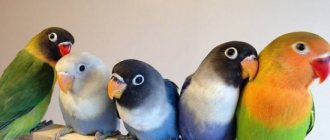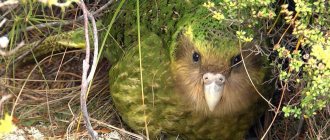Parrots are one of the species of the large parrot family. Representatives of this species include such popular birds among bird lovers as:
- Alexandrian necklace parrot.
- Indian ringed parrot.
- Blue-necked parrot.
It is these representatives of the Ozherelov family that have recently become the most popular among home collectors.
Appearance
These birds are very beautiful. Most representatives have green plumage, with minor splashes of other shades. Representatives of the blue-necked parrot have blue plumage. On the body of these birds, there is one characteristic feature that separates them from representatives of other species of the family - a multi-colored stripe bordering the neck. It is because of this that representatives of the species were called necklaces.
The color of the stripe is different for representatives of different species of necklaces.
Height and weight
Birds belong to the category of medium-sized parrots. Their length ranges from 30 to 60 millimeters. The body weight of zherelovids is from 110 to 125 grams.
Talking or not
Necklace parrots are easy to train and easily imitate various sounds, including human speech. Most birds can learn up to 60 words, especially if the pet has lived with its owner since birth.
Compared to males, females practically do not speak. To teach your pet to talk, it is not recommended to buy him a pair. The parrot will be constantly distracted by its neighbor. During the training process, it is strictly forbidden to shout or use violence. It is necessary to start with simple sounds and gradually complicate the words.
Necklace parrots. Keeping, feeding, breeding, caring for birds
Spreading
Lives in two parts of the world - Asia and Africa. Its representatives can often be found in South Asia and the African tropics.
A representative of the Ozherelov species, the Indian ringed parrot has the widest distribution among the parrot family. He lives in two parts of the world - Asia and Africa.
In Asia, it is found in India, Pakistan, Nepal, Ceylon, and Myanmar. In Africa, it lives in the lands of Nigeria, Ghana, Burkina Faso, Chad, Ethiopia, Cameroon, Djibouti, Uganda, and Ethiopia.
Diet
Natural food for these birds is all kinds of seeds, vegetables and fruits. A fairly powerful beak allows it to pierce the shell of various fruits, removing and eating their pulp and seeds.
The diet in captivity should be as similar as possible to the natural diet. This means that the feeder must have:
- Seeds and grains.
- Fruits.
- Vegetables.
What does the necklace parrot eat?
Photo: Necklace parrot
About 80 percent of this bird's diet is based on seeds. In addition, the necklace parrot also eats insects, fruits and nectar. These birds live in areas where there is an abundance of nuts, seeds, berries, vegetables, buds and fruits, which are complemented by other crops such as wheat, corn, coffee, dates, figs and guavas. These foods ripen at different times, supporting the parrot throughout the year. If food is scarce, for example due to a bad harvest, the parrot switches from its usual food supply to any plant matter it finds.
Large flocks of ringed parakeets noisily set off at dawn to feast on densely laden fruit trees or spilled grain. Wild herds fly several miles to forage on farmland and gardens, causing significant damage to owners. The birds themselves learned to open bags of grain or rice on farms or railway warehouses. The bird's sharp beak can easily tear hard-skinned fruits and open hard-shelled nuts.
Fun Fact: In captivity, parakeets will consume a variety of foods: fruits, vegetables, pellets, seeds, and even small amounts of cooked meat for protein. Oils, salts, chocolate, alcohol and other preservatives should be avoided.
In India they feed on grains and pigeon peas in winter. In Egypt, in the spring they feed on mulberries, and in the summer on dates, and nest on palm trees near fields with sunflowers and corn.
Now you know what to feed the necklace parrot, let's see how it lives in its natural environment.
Duration and lifestyle
At home, the necklace parrot lives up to 25 years. Some experts believe that these birds can live 40 and 50 years. In the wild, life expectancy decreases sharply for a number of reasons:
- Habitat degradation due to deforestation.
- A large number of predatory animals that love to feast on them.
- Poaching.
They prefer to nest in the hollows of tall trees growing in forests. They live in large groups, which can number tens or hundreds of individuals. Early in the morning they fly out in search of food. During lunch they take a short break for rest and sleep. After the break, the search for pasture continues. In the evening they fly to their permanent nesting sites, where they spend the night.
Character and intelligence
By nature, these representatives of birds are sociable, calm and very obedient to their owner. The pets happily greet him every time after a long absence. They rarely show aggression. The owner does not need to fear that the bird will suddenly attack him.
Very curious. Sometimes this can lead to negative consequences. Out of curiosity, they can accidentally damage their beak by hitting it hard on the bars of the cage, break the electrical cable, or peck at things the owner needs.
They love toys. They are especially attracted to small mirrors, into which they can look for hours, admiring their images. It is advisable to hang mirrors within easy reach.
They have a negative attitude towards other feathered pets. They may be aggressive towards those who:
- Weaker and smaller than them.
- Same gender as them.
They immediately try to take a dominant position in relation to other poultry, and do not allow the latter to approach the drinking bowl, feeder, or toys.
Therefore, they can only be kept together in the same cage with equally strong representatives of the species or representatives of larger species that will not allow themselves to be pushed around.
The intellectual level is quite high. They are able to remember and reproduce the sounds of other birds, as well as human speech. Vocabulary varies depending on the species to which the ringtailed parrot belongs. Some species can reproduce up to 60 words, others up to 250. But we must remember that there are species that cannot reproduce human speech at all. The clarity and clarity of their speech depends on individual abilities, as well as the patience and skill of the person who wants to teach the necklace parrot to talk.
Preparation
Before purchasing a parrot, you should prepare its home. Of course, a cage is suitable as housing. However, to make the bird feel more comfortable indoors, you can create a special corner, the so-called “sports” corner, where it could climb various perches, artificial branches, etc. Such a corner should be equipped away from drafts.
Microclimate in the apartment
Despite the unpretentiousness of a feathered pet, there are still certain requirements for the microclimate:
- The room temperature should be from 15 degrees, no less. Although ringed parrots tolerate cool weather well, they are still more comfortable in warmth;
- air humidity - from 60% to 70%;
- The parrot's wakefulness should not exceed 12 hours; the rest of the time it should spend sleeping, in complete darkness. To do this, you need to turn off the lights in the room or artificially create darkness using a cloth draped over the cage.
Safety
The first thing to remember is that open windows are a direct threat to your pet’s health. Therefore, the best way to keep your bird safe and out of trouble is to keep the windows closed when the parrot is free.
The second thing to remember is the danger that electrical wires and sockets pose to birds. A parrot can easily chew through a live wire or break a socket. Therefore, if all the wires are on the surface, they should be placed in special boxes.
Various small parts containing lead or zinc can also pose a threat to the pet’s life. If a bird swallows even a small thing containing a dangerous metal, the poisoning will make itself felt within a couple of hours.
Cage requirements
As for the cell, it must meet certain requirements:
- the location of the cage should be such that the topmost perch, on which the bird will sit almost all the time, is at eye level or slightly lower;
- It is better that the stand under the cage has wheels;
- Feeders should be purchased from durable, high-quality plastic, and they must be securely fastened to the bars of the cage;
- the bird's house should be located away from drafts, so placing it in the aisle is not the best option;
- The height of the cage is at least 0.7 m, and the width is 0.5 m.
Equipment
Equipment in the cage should include perches, a sippy cup and a feeder. Your pet may get bored of sitting idle in a cage all the time; to avoid this, you should place various toys, small mirrors or bells in the cage.
Keeping at home
Keeping these parrots at home is accessible even to novice hobbyists. Breeders just need to follow the rules and pay attention to some important points. If all instructions are followed as much as possible, the necklace pet will live in a cage for a long time and delight its owner.
Selecting a cage and accessories
The first crucial moment is the selection of the optimal cage for keeping. It must meet certain criteria. Firstly, its size must be at least 1x2 meters. The fact is that any type of necklace parrot, be it Mauritian, Indian, Alexandrian or blue, loves space. In a small cage, birds experience serious discomfort, which negatively affects the quality and duration of life.
Secondly, the cage must be made of durable and environmentally friendly materials - wood, modern environmentally friendly plastic, metal. Keeping a pet in a cage whose elements are made of cheap materials that emit harmful substances is unacceptable.
Thirdly, the cage itself must be made of high quality. All sorts of burrs or protruding small nails in the cage can be extremely dangerous for the bird, on which it can be injured.
In addition to the above, cage equipment is extremely important. It should have a feeder and a sippy cup. In addition to them, the presence of perches is mandatory. It is highly desirable if there are several of them. In this case, it is better to place them at different levels, but so that they are not located strictly one above the other.
The bird can jump from one to another and, thus, exhibit motor activity, which is important for any domestic animal. The same requirements apply to perch materials as to cage materials. In addition to the perches, you can place a system of ladders and rings.
Preparing a balanced diet
Proper feeding of a feathered pet is one of the keys to its long and prosperous life. It is advisable to feed him the food that he eats in the wild. First of all, this type of food includes grain.
Therefore, there should always be a grain mixture in the feeder.
It can be made based on:
- Millet grain.
- Oats.
- Canary seeds.
- Sunflower.
Parrots react very positively to various nuts. They love to break through nut shells and get out all the insides, which are then eaten by birds.
The right solution would be to use food additives in the form of vegetables and fruits (tangerine, orange and other citrus fruits). Parrots eat all this in their natural environment.
Therefore, vegetables and fruits are natural food for pets.
Bathing
Initially, washing should consist of carefully spraying the young pet with a spray bottle. The water must be warm. After some time, you can transfer the chick to a full bath. For this purpose, you can use a separate container filled with water about 2-3 centimeters deep.
Education and training
For the first few days of the acquired chick, it is better not to disturb it unnecessarily. The pet has not yet adapted to the new conditions and is experiencing stress. There should always be food and water in the cage. To accustom the chick to your hands, you need to put food on your palm. Usually after 2-4 days the chicks calmly feed from the owner’s hands.
After the chick is tamed, speech training can begin. To do this, you need to take the chick in your arms 2-3 times a day and, raising it to your lips, pronounce phrases loudly and clearly. After a few weeks, the pet will begin to repeat them. The chick should be no more than 3-4 months old.
Diseases and prevention
The main cause of disease is improper care of your pet. Their main external signs are changes in behavior, such as:
- Lethargy.
- Apathy.
- Rapid and intermittent breathing.
- Sleeping on two legs.
If these symptoms are present, it is better to immediately show your pet to a veterinarian to establish a diagnosis and develop a treatment algorithm.
Proper care is the basis for preventing diseases in parrots.
Purchase rules
It is customary to take parrots home when they are very young, so that it is easier for them to get used to their new owner. After the first two months of life, the chick does not need parental care, it becomes independent, and it is at this time that you should buy it. At this age, the bird has a small size, an orange beak, and no necklace, so the likelihood of error is minimal.
Nuances of choice:
- The parrot should be well-fed, with a rounded sternum, smooth plumage;
- A healthy bird is active and curious, a sick bird is apathetic, disheveled, and drowsy;
- A lot of feathers in the cage, undertails stained with droppings are signs of a serious illness. This is not worth buying.
It is recommended to take a ringed parrot for home keeping from a specialized nursery or purchase it from a reputable breeder. Buying from an advertisement or at the poultry market is very risky, as you can buy an individual of the wrong breed, with developmental or behavioral defects.
Reproduction
The process is generally similar to that of other species, but has a number of individual characteristics.
Preparatory procedures
Sexual maturity is reached at 3-4 years. During the mating season, adult birds create pairs. They are stable, but at the same time, partners do not always stay together all their lives.
After mating, they make nests in the hollows of old trees.
Laying eggs and caring for chicks
Egg laying takes 1-2 days. Their number usually does not exceed 4, although according to some data it can reach up to 6. Only the female incubates the eggs. This process lasts 22-24 days. Like other species of parrots, chicks at the beginning of life are completely dependent. The chicks remain in the nest for 6-7 weeks.
Determination of gender
Up to 3 years of age, gender can only be determined with 100% accuracy using a special analysis. There are several indirect ways to distinguish a boy chick from a girl. A few words need to be said about each of them.
By color and dark ring around the neck
Females are more dull in color. They do not have a “necklace” - a black and pink stripe around the neck.
According to the shape and size of the head, beak
The head of females is more rounded than that of males. The latter are also distinguished by a more saturated color of the cheeks and beak.
By the paws
The paws of female chicks are slightly more powerful and larger than the paws of males. The legs of female birds themselves are somewhat thicker and shorter than those of male chicks.
Tail length
The tail of a male pet is usually slightly longer than that of a female.
By behavior
You need to place a small mirror in the cage and watch your pet. Males, seeing their reflection, begin to show beauty - they constrict their pupils and open their wings. Female chicks behave differently - they tilt their heads back and constrict their pupils in the same way.
Laboratory DNA test
One of all, giving an accurate result. The probability of error is 0.1%. For analysis, it is not necessary to remove the necklace chick from the cage and take the chick to the laboratory. Simply providing a few pet feathers is enough.
The necklace parrot is a very interesting species of bird. Its representatives can be successfully kept in a home cage.
Previous
All typesThe most expensive parrots in the world
Next
All types of Azure parrot and its features
Individual characteristics of the breed
Necklace parrots are one of the most unpretentious birds, which is why they have become so popular. Breeding necklace parrots at home does not bring significant trouble to breeders.
Personal characteristics of this parrot breed
Pets have been delighting their owners with their bird trills since antiquity. In addition, they have a bright light green color and a pink stripe on the neck, thanks to which they received the name “necklace”.
Scientific research has proven that the brain of these birds is quite well developed and all owners confirm this.
That is why, if you put in a little effort and patience, the parrot will soon be able to easily imitate human speech. His vocabulary can be quite rich. Sometimes it reaches 200 words.

